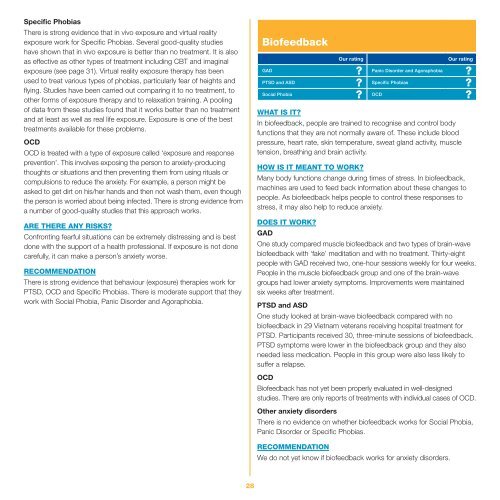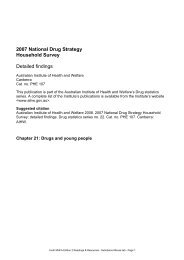A Guide To What Works For Anxiety Disorders - Mental Health First Aid
A Guide To What Works For Anxiety Disorders - Mental Health First Aid
A Guide To What Works For Anxiety Disorders - Mental Health First Aid
You also want an ePaper? Increase the reach of your titles
YUMPU automatically turns print PDFs into web optimized ePapers that Google loves.
Specific PhobiasThere is strong evidence that in vivo exposure and virtual realityexposure work for Specific Phobias. Several good-quality studieshave shown that in vivo exposure is better than no treatment. It is alsoas effective as other types of treatment including CBT and imaginalexposure (see page 31). Virtual reality exposure therapy has beenused to treat various types of phobias, particularly fear of heights andflying. Studies have been carried out comparing it to no treatment, toother forms of exposure therapy and to relaxation training. A poolingof data from these studies found that it works better than no treatmentand at least as well as real life exposure. Exposure is one of the besttreatments available for these problems.OCDOCD is treated with a type of exposure called ‘exposure and responseprevention’. This involves exposing the person to anxiety-producingthoughts or situations and then preventing them from using rituals orcompulsions to reduce the anxiety. <strong>For</strong> example, a person might beasked to get dirt on his/her hands and then not wash them, even thoughthe person is worried about being infected. There is strong evidence froma number of good-quality studies that this approach works.ARE THERE ANY RISKS?Confronting fearful situations can be extremely distressing and is bestdone with the support of a health professional. If exposure is not donecarefully, it can make a person’s anxiety worse.RECOMMENDATIONThere is strong evidence that behaviour (exposure) therapies work forPTSD, OCD and Specific Phobias. There is moderate support that theywork with Social Phobia, Panic Disorder and Agoraphobia.BiofeedbackOur ratingOur ratingGAD? Panic Disorder and Agoraphobia ?PTSD and ASD? Specific Phobias ?Social Phobia? OCD ?WHAT IS IT?In biofeedback, people are trained to recognise and control bodyfunctions that they are not normally aware of. These include bloodpressure, heart rate, skin temperature, sweat gland activity, muscletension, breathing and brain activity.HOW IS IT MEANT TO WORK?Many body functions change during times of stress. In biofeedback,machines are used to feed back information about these changes topeople. As biofeedback helps people to control these responses tostress, it may also help to reduce anxiety.DOES IT WORK?GADOne study compared muscle biofeedback and two types of brain‐wavebiofeedback with ‘fake’ meditation and with no treatment. Thirty‐eightpeople with GAD received two, one-hour sessions weekly for four weeks.People in the muscle biofeedback group and one of the brain-wavegroups had lower anxiety symptoms. Improvements were maintainedsix weeks after treatment.PTSD and ASDOne study looked at brain-wave biofeedback compared with nobiofeedback in 29 Vietnam veterans receiving hospital treatment forPTSD. Participants received 30, three-minute sessions of biofeedback.PTSD symptoms were lower in the biofeedback group and they alsoneeded less medication. People in this group were also less likely tosuffer a relapse.OCDBiofeedback has not yet been properly evaluated in well-designedstudies. There are only reports of treatments with individual cases of OCD.Other anxiety disordersThere is no evidence on whether biofeedback works for Social Phobia,Panic Disorder or Specific Phobias.RECOMMENDATIONWe do not yet know if biofeedback works for anxiety disorders.28




